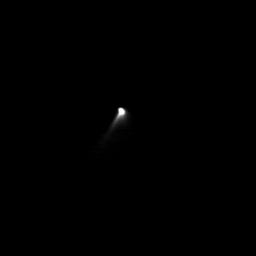
|
Early Close Image of Comet Borrelly
- Click the image above for a larger view
- Full-Res JPEG (500 x 500) (3.7 kB)
- Full-Res TIFF (500 x 500) (9.3 kB)
Caption:
The solid nucleus of comet Borrelly is barely resolved in this image, enhanced to reveal the highly collimated dust extending towards the bottom left corner of the picture. The jet is attributed to dust carried outward by gas expanding outwards into a cone about 20 degrees across. The surface of Borrelly is composed of a mixture of dust and water ice, and as the comet approaches the Sun the water ice sublimes. The gases produced inside the comet by the Sun's heating race away from the surface into the vacuum of space, carrying the dust away with them. The jet was also seen in images acquired around 9 hours earlier. This suggests that the emission is coming from close to the rotation axis at the comet's constantly illuminated pole. The Sun is at the bottom of the image.
Background Info:
Deep Space 1 completed its primary mission testing ion propulsion and 11 other advanced, high-risk technologies in September 1999. NASA extended the mission, taking advantage of the ion propulsion and other systems to undertake this chancy but exciting, and ultimately successful, encounter with the comet. More information can be found on the Deep Space 1 home page at http://nmp.jpl.nasa.gov/ds1/ .
Deep Space 1 was launched in October 1998 as part of NASA's New Millennium Program, which is managed by JPL for NASA's Office of Space Science, Washington, D.C. The California Institute of Technology manages JPL for NASA.
Cataloging Keywords:
| Name | Value | Additional Values |
|---|---|---|
| Target | 19P/Borrelly | |
| System | Periodic Comets | |
| Target Type | Comet | |
| Mission | Deep Space 1 (DS1) | |
| Instrument Host | Deep Space 1 | |
| Host Type | Flyby Spacecraft | |
| Instrument | Miniature Integrated Camera Spectrometer (MICAS) | |
| Detector | ||
| Extra Keywords | Dust, Grayscale, Rotation, Water | |
| Acquisition Date | ||
| Release Date | 2001-11-03 | |
| Date in Caption | ||
| Image Credit | NASA/JPL | |
| Source | photojournal.jpl.nasa.gov/catalog/PIA03506 | |
| Identifier | PIA03506 | |
